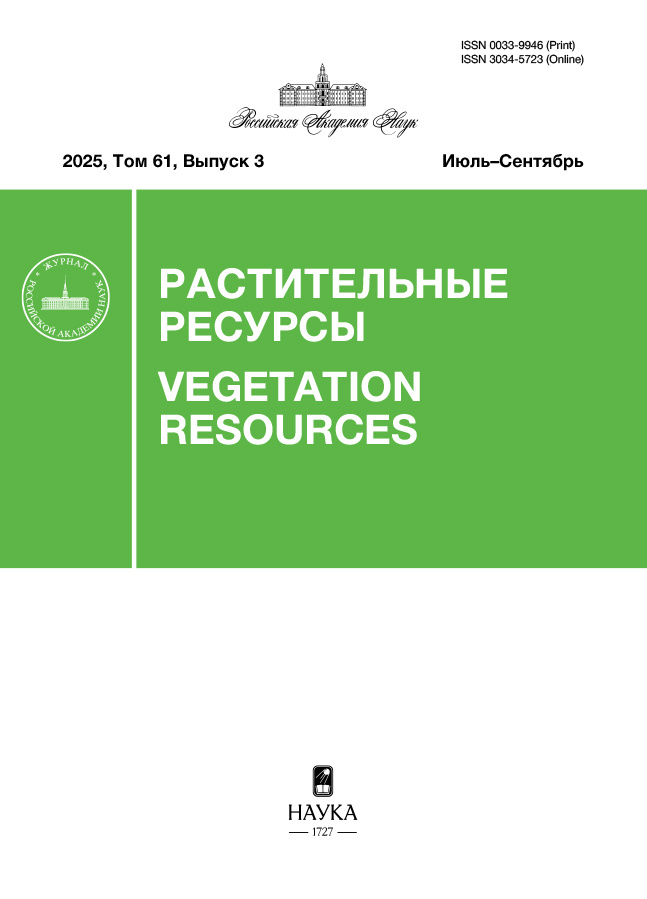Flavonoids of Cirsium vlassovianum (Asteraceae)
- Autores: Myagchilov A.V.1,2, Kalinin A.I.1, Sokolova L.I.1, Boyko E.V.2
-
Afiliações:
- Far Eastern Federal University
- G. B. Elyakov Pacific Institute of Bioorganic Chemistry FEB RAS
- Edição: Volume 61, Nº 3 (2025)
- Páginas: 114-118
- Seção: Component Composition of Resource Species
- URL: https://rjeid.com/0033-9946/article/view/695435
- DOI: https://doi.org/10.7868/S3034572325030081
- EDN: https://elibrary.ru/ygnzis
- ID: 695435
Citar
Texto integral
Resumo
Currently, special attention is paid to plants of the genus Cirsium Mill. (Asteraceae) used in traditional medicine as medicinal raw materials with antibacterial, nootropic and anti-inflammatory properties. In addition, Cirsium species are used in folk medicine as anti-ulcer and vulnerary agents. The therapeutic properties of these plants are due to the content of phenolic compounds, especially flavonoids. Cirsium vlassovianum Fisch. ex DC., is one of the poorly studied plants growing in the Russian Far East, the flavonoid composition of which has not been examined. Three flavonoids were isolated from the aboveground part of C. vlassovianum by extraction, column chromatography, and RP-HPLC methods: hispidulin (1), hispidulin-7-O-β-glucopyranoside (2), and pectolinarin (3). The structure of the isolated compounds was confirmed by NMR-spectroscopy. By the method of RP-HPLC—MS/MS in the initial alcoholic extract of C. vlassovianum, six more flavonoids were identified: rutin (4), cynaroside (5), apigenin-7-O-β-glucuronopyranoside (6), apigenin (7), kaempferol (8), isokaempferide (9). Therefore, this plant can be a promising source of biologically active compounds.
Sobre autores
A. Myagchilov
Far Eastern Federal University; G. B. Elyakov Pacific Institute of Bioorganic Chemistry FEB RAS
Autor responsável pela correspondência
Email: dfdfdf47@yandex.ru
Vladivostok, Russia; Vladivostok, Russia
A. Kalinin
Far Eastern Federal University
Email: dfdfdf47@yandex.ru
Vladivostok, Russia
L. Sokolova
Far Eastern Federal University
Email: dfdfdf47@yandex.ru
Vladivostok, Russia
E. Boyko
G. B. Elyakov Pacific Institute of Bioorganic Chemistry FEB RAS
Email: dfdfdf47@yandex.ru
Vladivostok, Russia
Bibliografia
- Тараховский Ю. С., Ким Ю. А., Абдрасилов Б. С., Музафаров Е. Н. 2013. Флавоноиды: биохимия, биофизика, медицина. Пущино. 310 с. http://biophenols.ru/wp/wp-content/uploads/2013/11/Tarahovsky.pdf (дата обращения 18.05.2025)
- Растительные ресурсы России: Дикорастущие цветковые растения, их компонентный состав и биологическая активность. 2013. Т. 5. Семейство Asteraceae (Compositae). СПб.; М. 312 с.
- Kim H. H., Jeong S. H., Park M. Y., Bhosale P. B., Abusaliya A., Kim H. W., Seong J. K., Kim D. I., Lee S. J., Park K. I., Kim G. S. 2024. Potential antioxidant and anti-inflammatory properties of polyphenolic compounds from Cirsium japonicum extract. — Int. J. Mol. Sci. 25(2): 785. https://doi.org/10.3390/ijms25020785
- Nazaruk J., Chłędzik S., Strawa J., Bazydło K., Wajs-Bonikowska A. 2017. Chemical composition and antioxidant activity of Cirsium vulgare inflorescences. — Nat. Prod. Commun. 12(4): 519—522. https://doi.org/10.1177/1934578X1701200414
- Griškevičienė U., Marksa M., Ževžikovienė A., Kazlauskienė D., Vainorienė R., Ževžikovas A., Ivanauskas L. 2021. Cirsium vulgare leaves: isolation and identification of phenolic compounds. — Chemija. 32(3—4): 92—99. http://doi.org/10.6001/chemija.v32i3-4.4547
- Kozyra M., Biernasiuk A., Malm A., Chowaniec M. 2015. Chemical compositions and antibacterial activity of extracts obtained from the inflorescences of Cirsium canum (L.) All. — Natural Product. Research. 29(21): 2059—2063. http://doi.org/10.1080/14786419.2015.1030341
- Nazaruk J., Czechowska S. K., Markiewicz R., Borawska M. H. 2008. Polyphenolic compounds and in vitro antimicrobial and antioxidant activity of aqueous extracts from leaves of some Cirsium species. — Nat. Prod. Res. 22(18): 1583—1588. https://doi.org/10.1080/14786410701825053
- Loizzo M. R., Statti G., Tundis R., Conforti F., Ando S., Menichini F. 2004. Antimicrobial activity and cytotoxicity of Cirsium tenoreanum. — Fitoterapia. 75(6): 577—580. https://doi.org/10.1016/j.fitote.2004.03.011
- Hase T., Ohtani K., Kasai R., Yamasaki K., Picheansoonthon Ch. 1995. Revised structure for hortensin, a flavonoid from Millingtonia hortensis. — Phytochemistry. 40(1): 287—290. https://doi.org/10.1016/0031-9422(95)00206-M
- Ye Y., Chen Z., Wu Y., Gao M., Zhu A., Kuai X., Luo D., Chen Y., Li K. 2022. Purification process and in vitro and in vivo bioactivity evaluation of pectolinarin and linarin from Cirsium japonicum. — Molecules. 27(24): 8695. http://doi.org/10.3390/molecules27248695
- Lopez-Lazaro M. 2009. Distribution and biological activities of the flavonoid luteolin. — Mini Rev. Med. Chem. 9(1): 31—59. http://doi.org/10.2174/138955709787001712
Arquivos suplementares










